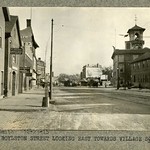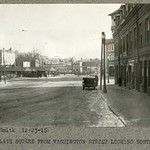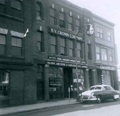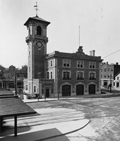|
The Society
Historical Information
Photo & Map Collections
Exploring Brookline
Links
Program Archives
|
Brookline Village
 |
High St. Corner, Brookline Village, circa 1905
Standing on the corner of Walnut St. and High St. looking northeast towards Lower Washington St. Left, on High St., is the rear of Henry J. Pineo, Carpenter and Builder. On the corner, with Walnut St. going to the right, are several outbuildings of Michael W. Quinlan, Carriages and Harnesses, whose main business is off screen to the left, on the corner of Boylston St. and High St.
[Source: Digital Commonwealth]
|
 |
High St. Corner, Brookline Village, circa 1905
Standing on today's Rt.9. To the left is the corner of Hose House #1 and Chemical Engine #1. To the right of that, also on Lower Washington St. is P. J. Burns, Horse Shoe Forge. On the upper right, are the High St. businesses of George M. and Thomas K. Forster, Upholsterer and Henry J. Pineo, Carpenter and Builder.
[Source: Digital Commonwealth]
|
 |
Lower Washington St., Brookline Village, circa 1898
Looking east at Lower Washington St. from Boylston St. This photo contains a rare view of the north side of Lower Washington St.
On the far left is the wooden structure known as the "Russell Block". From left to right it houses:
- [153 Washington St.] The kitchenware and variety store of Albert Levien. Levien was a Russian immigrant who arrived in the United States in 1882, at the age of nineteen. He first had a store just over the Boston border on Tremont St. but soon moved to this location in 1888. He lived upstairs for the first sixteen years and maintained the store for over thirty years.
- [145-147 Washington St.] The store with the three awnings is the provisions store of Thomas S. Brown
- [137-139 Washington St.] J. V. Pyne & Co., dry goods
The large brick building to the right of the Russell Block, 127-131 Washington St., houses Jacob Morlock's "Bakery, Restaurant, Provisions" with the Morlock Hotel on the upper floors.
On the right side of the photo, from right to left, the identifiable structures are Hose House #1/Ladder #2 followed by Sing Lee’s Laundry. Hook and Ladder Co. #2 was only briefly located here, between late 1897 to mid-1899, before moving to the fire station at 342 Washington St.
[Source: Digital Commonwealth]
|
 |
Brookline Village, circa 1909
The new fire station, just completed in 1908, is partially visible on the left followed by M. W. Quinlan’s carriage shop. Visible on the right are John H. Shea, Horse Shoer at 21 Boylston St.; J. O'Day, Stables at 19 Boylston St.; Crawford O' Hart, Tinsmith and Coleman and Horton, Cigars at 11 Boylston St.
The trolley car is from the Boston and Worcester Street Railway Co. The route started at Park Sq. sharing standard trolley tracks then switched to its own B & W tracks at an interchange just west of Chestnut Hill. The route continued to Worcester and the cars could travel at 60 mph once outside the local Boston environs. The telescoped photo obscures the fact that these cars were longer than the local trolley cars running in Brookline.
|
 |
Village Square, November 9, 1899
Looking east at Lower Washington St. from the beginning of Boylston St. At the immediate left, at #1 Boylston St., is the workshop of the Johnson Bros., Masons. The photograph is dated November 9, 1899 by the Town Engineer who was taking elevations for an encroachment case, note the measuring pole held by the man. The latter appears to be the same man holding a pole in this photo.
[Source: Brookline Preservation Department]
|
 |
Boylston St. Looking East, December 23, 1915
Note in particular the now-halved advertisement for “Pure-Clean Quaker Oats”. In late 1912, Boylston St. was widened and approximately ten feet of the Guild Building removed. From left to right on that side of the street are seen:
- 21 Boylston St.: Nathaniel L. Walker, carpenter
- 21 Boylston St.: John J. Horgan, horse shoer
- 19 Boylston St.: John S. O’Day, stables
- 7 Boylston St.: Martin Geier, hairdresser. The building at 7-11 Boylston was constructed in 1912 and still stands today.
- 160 Washington St.: the Guild Building
[Source: Olmsted]
|
 |
Brookline Village, circa 1875
This is the oldest known photograph of the Village which includes the “Guild Block”. On the corner is J. Anson Guild’s grocery store which was a Village fixture for many years. On the right side of the building are a number of small businesses: wheelwright, fish market, barber, plumber. The top floor was called “Goddard Hall” and was used for dances and meetings.
Only one side of Washington St. has a bridge over the railroad tracks. The small road to the right is essentially another lane of Washington St. with additional access under the bridge to White Place. In ten years, the bridge would extend across both lanes and the entrance to White Place would be raised to that level.
[Source: Brookline Public Library]
|
 |
Brookline Village, Guild Block Building, circa 1903
Boylston St. looking west to the left; Washington St. on the right. Pictured from left to right:
[#164 Washington St.] On the corner of the Guild Block building, the faded sign of the previous owner of the grocery store, Francis H. Bacon, is still visible to the right. Thomas F. McMahon, who had been a clerk in Bacon’s store, took over the business when Bacon died in 1898.
[#172 Washington St.] Henderson Dairy and T. A. Conroy, Gas and Electric Fixtures.
[#174 Washington St.] Horace James, Mason
[#176 Washington St.] George P. Johnson Fish Co.
[#178 Washington St.] W. H. Pazolt, Sign and Carriage Painting; and F. H. McMahan, Plumber
|
 |
Brookline Village, December 23, 1915
Washington St. looking south. Start of Boylston St. background right. Guild building, foreground right. Only the fire station, partial view, remains.
[Source: Olmsted]
|
 |
Brookline Village, Washington St.
Looking north on Washington St. Only one side of Washington St. has a bridge over the railroad tracks. The small road to the right is essentially another lane of Washington St. with additional access under the bridge to White Place. In 1888, the bridge would be extended across both lanes.
|
 |
Brookline Village, circa 1913
Washington St. looking north. On the far left, the removal of the side of the Guild Building facing Boylston St. can be partially glimpsed. This was to accommodate the 1912 widening of Boylston St.
[Source: Digital Commonwealth]
|
 |
Brookline Village, Village Square, 1885
The side road shown here will soon become part of the widening of Washington St. and its bridge over the tracks. Today's Rt. 9 is in the distance, Boston to the left.
[Source: Digital Commonwealth]
|
 |
Brookline Village, circa 1910
Washington St., looking south at the Village Square
- [173 Washington St.] a partial view of the building
- [167/163 Washington St.] Edward J. Cameron, shoemaker (left) and Michael O'Keeffe, grocer (right)
- Trolley stand
- [Corner, Morss Ave. & Walnut St.] The large taxi billboard is sitting on top of the Brookline Riding School building at 2 Walnut St. Morss Ave is to the left. The building had been the barn housing the horse-drawn cars for the Metropolitan Railway Co.
- [6 Walnut St.] Macleod Bros. Furniture and Piano Moving
- [22 Walnut St.] immediately to the right of the “Renting an Automobile” sign is the store of Nils Lilja, Painting and Decorating
- [140 Washington St.] New fire station completed in 1908 and still in use today
- [#164 Washington St.] Thomas H. McMahon, grocer, on the corner of the Guild Block building, sign visible
- [#166 Washington St.] Forster Bros., Upholsterers, upstairs in the Guild Block building, sign visible
- [#166 Washington St.] T. A. Conroy, Gas and Electric Fixtures, upstairs in the Guild Block building, sign visible
[Source: Joel Shield]
|
 |
Lower Washington St. at Walnut St.
Looking east with Walnut St. coming in from the right. Partial view of the Brookline House, 108 Washington St., an eating establishment and boarding house started by Aaron Whitney circa 1865 and closed circa 1874.
Photo from the Brookline Chronicle, July 8, 1943
|
 |
Brookline Village, September, 1938
The two films on the marquee played at the New Brookline Theater from September 8-10. In the distance, a bus prepares to turn right from Brookline Ave. onto Lower Washington St. In an effort to reduce the heavy traffic congestion in the Village, it had recently been decided to substitute busses for the trolleys on the Allston-Dudley route. The trolley transfer stations are being removed. None of the buildings in the photo still stand.
[Source: Digital Commonwealth]
|
 |
Lower Washington St., 1956
From left to right:
- 137 Washington St., Davis Restaurant
- 131 Washington St., Sagamore Liquors
- 127 Washington St., Hughes Pharmacy
- 123/123 Washington St.
- 115/117 Washington St.
- 105-113 Washington St. block including Brookline Village Shoe Store at #109, Mutual Auto School at #107, and the now-closed movie theater
- 103 Washington St., partial view of the White Tower restaurant
[Source: Digital Commonwealth]
|
 |
92-100 Washington St.
The final building at 104-108 Washington St. has recently been demolished and replaced by a gas station (off photo)
[Source: Brookline Preservation Department]
|
 |
Village Square, 1912
Looking east at Lower Washington St. from Boylston St. From left to right:
- 160 Washington St.: Guild Building. at the corner. This side of the building would soon be removed for the widening of Boylston Street.
- 7 – 11 Boylston St., under construction. The demolition permit for the existing building (9-11 Boylston St.), affected by the incipient widening of Boylston Street, was granted in July, 1912; construction was completed by the end of the year; and a new address, #7, was added.
- 7 Boylston St.. After many years at 157 Washington St., hairdresser Martin Geier is about to move his business here.
- 5 Boylston St., the fading sign for the grocery store of Francis H. Bacon remains but the business was taken over by Thomas McMahon a number of years ago.
- 166 Washington St., upstairs in the Guild Building. Signs for Forster Bros., Upholsterers and
The Brookline Print (Wallace B. Conant and Carl A. Smith), job printers, are visible.
- 157 Washington St., in the distance, the sign for Brookline Provisions is visible.
[Source: Brookline Preservation Department]
|
 |
Fire Station #1, Brookline Village, circa 1910
From left to right:
- 32 Allerton St., rear, high on the hill (still standing)
- 34 Walnut St., Edward J. Kirker, Real Estate; Brookline Press
- 38 Walnut St.: Mark Bergstein, Tailor
- 40 Walnut St.: Eagle Hand Laundry
- The fire station. Note underground toilets to the left.
- 1 High St.: Michael W. Quinlan, Carriage Mfg.
- 9 High St., brick apartment building, partial view
[Source: Brookline Preservation Department]
|
 |
Bike Parade, circa 1900, Brookline Village
Looking at the west side of Washington St. across from Station St. This is most likely a Fourth of July parade. The stores pictured were at this location in 1899 and 1900. From left to right:
- #188, James Terry, Shoe Repair (partial)
- #192, Thomas Mahon and Sons, Plumbers
- #194, Flately and Sweeney, Custom Tailors
- #198, John T. Cahill, Provisions
- #200, James B. Hand, House Painter and Decorator
- #208 Washington St., the Chace building, still standing (partial)
[Source: Brookline Preservation Department]
|
|